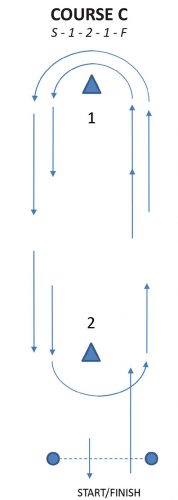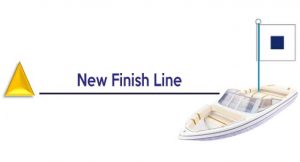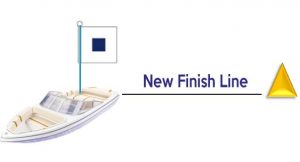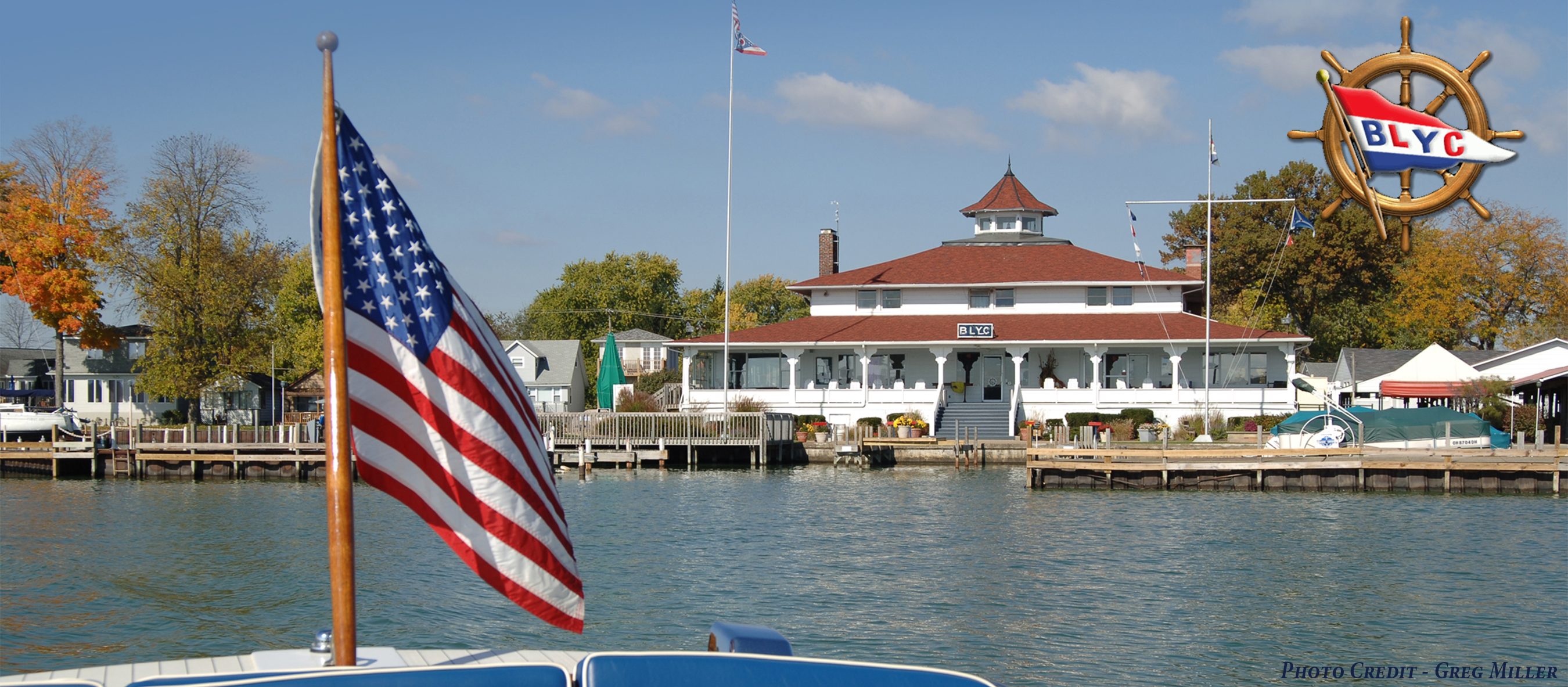Often, we focus our rules discussions only on Part 2 of the rules – “When Boats Meet.” This winter, I plan to explore the rules of Part 3 – “Conduct of a Race.” They may appear to only matter to the Race Committee, but they have significant importance to the racing sailor too.
– Steve Harris, US Sailing National Race Officer
Rule 32 - Shortening or Abandoning After the Start
Last week, we discussed the “abandoning” part of this rule. This week, we’ll look at how the Race Committee can shorten the course under this rule. If you didn’t read last week’s post, you can click here to do so.
Let’s look at the text of the rule…
NOTE – Rule 32 only applies after the start. Rule 27.3 allows the race committee to abandon before the start for any reason.
32.1
“After the starting signal, the race committee may shorten the course (display flag S with two sounds) or abandon the race (display flag N, N over H, or N over A, with three sounds)
- because of foul weather,
- because of insufficient wind making it unlikely that any boat will finish within the race time limit,
- because a mark is missing or out of position, or
- for any other reason directly affecting the safety or fairness of the competition,
In addition, the race committee may shorten the course so that other scheduled races can be sailed, or abandon the race because of an error in the starting procedure. However, after one boat has started, sailed the course and finished within the race time limit, if any, the race committee shall not abandon the race without considering the consequences for all boats in the race or series.”
32.2
“If the race committee signals a shortened course (displays flag S with two sounds), the finishing line shall be,
- at a rounding mark, between the mark and a staff displaying flag S;
- a line the course requires boats to cross; or
- at a gate, between the gate marks.”
The reasons that the RC can shorten the course are, essentially the same as those for which they can abandon. There are some key differences, however. Additionally, Rule 32.2 provides specific guidance on how the course is shortened.
I won’t delve into the enumerated reasons for shortening under 32.1 as those were discussed in detail last week. However, Rule 32.1 also provides the following:
“In addition, the race committee may shorten the course so that other scheduled races can be sailed…”
The reasons for this additional directive may not seem readily apparent. But, simply put, there are often reasons to get more races in:
- Most often, becuase the SIs require a minimum number of races – greater than 1 – to count as a series.
- Sometimes, in a very competitive event, when scores are “tight,” it may be advisable to have more races rather than less, to give all competitors the greatest chance of finishing well over all. (i.e., keep the competition on the water, not in the hands of the race or protest committees)
- Generally, its felt that “saving the race” is a better option that abandoning. It’s no fun spending a lot of time fighting for a good finish to have the race committee “throw the race away.”
That said, race officers are advised in their training to carefully consider all factors when making the decision to shorten. Generally, course selection involves a number of good, well though out factors and changing that configuration “on the fly” by eliminating one or more legs may be counter to those reasons. But, the rule does provide race committees with that flexibility nonetheless.
What does it mean to “Shorten the Course?”
This is actually a point of confusion for many competitors and race committees alike. Intuitively, “shortening” implies keeping the course the same – same configuration, same number of legs & rounding marks, etc. – but making the distance less. That is not the case here.
Shortening the course is the elimination of legs of the course. What is described above is covered in RRS 33 – Changing the Next Leg of the Course (emphasis added).
Let’s look again at one of our “typical” courses at BLYC…

Under normal circumstances, sailing this course would entail the following (in order):
- Starting
- Rounding Mark 1
- Rounding Mark 2
- Rounding Mark 1 again
- Finishing
But… what if the wind starts dying off (and quickly) as most boats are rounding Mark 2 to start their 2nd windward leg. Looking at the reasons under which the RC is permitted to shorten…
- Is it likely that the first boat will finish within the time limit?
- If it is, is it still a fair race?
- Is this race valuable to series (i.e., “so that other scheduled races can be sailed”)
It may, very well, be desirable to try and “save” this race by shortening the course at the next mark (Mark 1, 2nd time) by eliminating that last leg to the finish.
As a side note… one thing that has become increasingly common in recent years, is race committees utilizing this rule to “finish closer to home” at the end of a race. That is, say in our Course C example above, the windward mark (Mark 1) is closer to where the boats are docked or hauled out. Eliminating the final leg finishes them closer to home than having them sail the final leg would. Certainly, it would be better if this was anticipated by the race committee and they chose a different course prior to the race instead, but that is not always feasible. In doing this, however, what part of Rule 32.1 allows this? I would contend that it could be a reason “… directly affecting the safety or fairness…” For example,
- Dying breeze – s a result of dying breeze, boats will need to be towed in. Towing a boat, even in light breeze and seas, is inherently more dangerous than the boat being sailed (or motored) in under the control of its crew
- Impending severe weather – while perhaps there is time to finish the boats by eliminating a leg, it is questionable whether or not there is time to finish and get the boats back to shore in time.
- Lateness of hour – it may be desirable to shorten the race in order to allow all boats to finish before nightfall. Depending on the boats competing, they may or may not have lights and other necessary safety equipment for night sailing.
How does the race committee shorten the course?
“… the race committee may shorten the course (display flag S with two sounds) …”

One interesting part of the rule is that there is no requirement as to when the flag and sound signal must be made. It only needs to be made in enough time that the first boat approaching the new finish mark (in our example above, the “old” Mark 1), sees and hears the signal to finish.
This is another frequent point of confusion and misunderstanding for many racing sailors. As we will see later with RRS 33 (Changing the Net Leg of the Course), those signals are made prior to boats sailing the leg. That is not the case with Rule 32 – and, in fact, it is for a very good reason.
If the shortening signal (eliminating a leg) was required to be signaled earlier, it may be too soon or not soon enough – think of the reasons to shorten… foul weather, insufficient wind, safety & fairness, etc. These are not things that can always be anticipated. Doing so might result in the signal being made unnecessarily (conditions improve) or, worse yet, leaving the race committee with only one option – abandonment – in the case of severe weather & safety.
Often, when considering shortening, the race committee will get everything ready, just in case, and the PRO will make the call at the last minute and direct the mark boat to hoist the flag with two sounds as the first boat is nearing the mark. How near? Close enough to see and hear the signals, yet not too close for it to be effective. Like many things with course management, it depends.
32.2
“If the race committee signals a shortened course (displays flag S with two sounds), the finishing line shall be,
- at a rounding mark, between the mark and a staff displaying flag S;
- a line the course requires boats to cross; or
- at a gate, between the gate marks.”
Rule 32.2 gives us the guidance on how, specifically this it to be executed. Let’s look at these one by one…
“1. at a rounding mark, between the mark and a staff displaying flag S;
This would be what we described in our Course C example above, the mark boat (or other boat signaling and taking the finishes) would set up such that competitors would finish between Flag S on their boat and the nearby mark.

- perpendicular to the course direction from the last mark
- anchored in position
- such that a boat rounding the mark as it “normally” would, it necessarily crosses the finish line without any need to sail the course differently than planned or intended
- As this mark was to originally be left to port, they would still be leaving it to port while finishing properly

In the above situation, how would I finish properly?
You would finish according to Rule 32.2(1) – “…between the mark and a staff displaying flag S”
While, originally, you would have left Mark 1 to port – it is no longer Mark 1. It is now a finish mark.
Recall the definition of Finish…
“A boat finishes when, after starting, any part of her hull crosses the finishing line from the course side.”
It may be tempting, or even seem necessary, to leave the mark to port (as you originally would have) and round it in order to cross the new finish line. Doing so, however, would be improper. You would be scored as DNF as you didn’t cross the line from the course side.
Before we look at 32.2(2), lets look ahead at what would happen at a gate…
“3. at a gate, between the gate marks.”
Although for our typical Sunday races we seldom use gates, most of us are familiar with them. Most commonly used for downwind marks, a gate (instead of being a single mark) is composed o two marks, which you pass between, rounding either one.
In the race committee signals a shortened course at the gate, rule 32.2 is easy to comply with – sail betwen them as you normally would.

As shown above, this would be the ideal way the mark boat would set up the new line. It would be…
- perpendicular to the course direction from the last mark
- anchored in position such that they can see both marks in order to judge the line properly
- close enough to one of the marks that there is no confusion as to how to cross (i.e. there is no temptation to cross between the boat and the mark nearest to it)
Again, however, there is no requirement in the rule to meet the above conditions.
2. “a line the course requires the boats to cross”
Although the set-up and execution of 32.2(2) is easy enough to understand (it is, essentially, identical to 32.2(3)), this is often a very confusing part of the rule.
Why would there be a line that boats are required to cross that isn’t already a gate? In most sailboat racing, such a thing simply doesn’t exist.
I’m not sure that the situation I’m about to describe is what the writers were thinking when this was added, but we have a situation here at BLYC where we have taken advantage of this part of the rule – our Holiday Long Distance Races.
As you area aware our start/finish line for these races is usually in front of the race committee shack on the island and is comprised of two marks (rather than a mark and a flag on a boat). In recent years, we’ve written the SIs for these races such that boats are required to pass through this line on all legs of the course. Many think that this is so we can make the racing more interesting for the holiday spectators at the Club. While that is an advantage for sure, it actually isn’t the primary reason that we did it. Statistically speaking it doesn’t seem possible, but we almost always have light winds for the Holiday races. By making boats cross the start/finish line on every leg, the race committee has the option to shorten the course at that line. While those races are intended to be distance races. That said, there comes a point that sailing for seemingly hours on end in light air is simply neither fun nor practical.
There’s a lot that we’ve unpacked from Rule 32 these past two weeks, but hopefully it’s a little more clear now as to how it works and some of its unique nuances.
